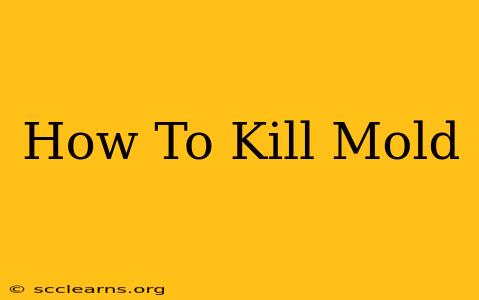Mold. Just the word conjures up images of damp basements, musty smells, and potential health hazards. But understanding how to kill mold effectively is crucial for maintaining a healthy and safe home environment. This comprehensive guide will equip you with the knowledge and strategies to tackle mold infestations, big and small.
Understanding Mold: The Enemy Within
Before we dive into eradication, let's understand our opponent. Mold is a type of fungus that thrives in damp, dark, and humid conditions. It reproduces through microscopic spores that travel through the air, making it easy for mold to spread throughout your home. Different types of mold exist, with varying levels of toxicity. Some are simply unsightly, while others can trigger allergies, asthma, or even more serious health problems. Early detection and prompt action are key.
Common Places Mold Lurks:
- Bathrooms: High humidity and moisture make bathrooms a prime breeding ground. Check around showers, tubs, and under sinks.
- Kitchens: Leaks under sinks, around appliances, or near windows can lead to mold growth.
- Basements: Basements are often damp and poorly ventilated, creating ideal conditions for mold.
- Attics: Similar to basements, attics can experience moisture problems leading to mold growth.
- Walls and Ceilings: Hidden leaks behind walls can cause significant mold problems that go unnoticed until it's severe.
How to Kill Mold: A Step-by-Step Approach
Tackling mold effectively requires a multi-pronged approach. Here's a step-by-step guide:
1. Safety First: Protective Gear is Essential
Mold exposure can be hazardous. Always wear protective gear before attempting to remove mold, including:
- Rubber gloves: Protect your hands from the mold and cleaning solutions.
- Eye protection: Prevent mold spores from getting into your eyes.
- N95 respirator mask: This mask filters out mold spores, protecting your respiratory system.
- Long sleeves and pants: Cover exposed skin to minimize contact with mold.
2. Assess the Damage: Size Matters
The size of the mold infestation will determine your approach. Small mold spots (less than 10 square feet) can often be handled with DIY methods. Larger infestations (more than 10 square feet) often require professional help.
3. Cleaning Small Mold Infestations: DIY Solutions
For small areas, you can effectively kill mold using these solutions:
- Bleach Solution: Mix one cup of bleach with one gallon of water. Always test this solution in an inconspicuous area first to ensure it doesn't damage the surface. Apply the solution to the affected area, scrub gently, and allow it to sit for 10-15 minutes before rinsing thoroughly.
- Borax Solution: Borax is a natural cleaning agent that's effective against mold. Mix one cup of borax with one gallon of water and apply as with the bleach solution.
- Vinegar Solution: White vinegar's acidity can inhibit mold growth. Apply undiluted white vinegar and let it sit for an hour or so before scrubbing and rinsing.
4. Dealing with Larger Infestations: When to Call a Pro
If the mold infestation covers a large area, penetrates building materials, or involves toxic mold species, do not attempt DIY remediation. Contact a qualified mold remediation professional. They have the expertise, equipment, and safety protocols to handle these complex situations.
5. Preventing Future Mold Growth: Proactive Measures
Preventing mold is just as important as killing it. Here's how:
- Reduce Humidity: Use dehumidifiers in damp areas and ensure proper ventilation.
- Fix Leaks Promptly: Repair any leaks in plumbing, roofs, or windows immediately to prevent moisture buildup.
- Improve Ventilation: Ensure proper ventilation in bathrooms, kitchens, and basements using exhaust fans.
- Regular Cleaning: Regularly clean and disinfect areas prone to mold growth.
Mold Removal: A Final Note
Removing mold can be a challenging task, but with the right approach and safety precautions, you can create a healthier home environment. Remember that early detection and quick action are crucial in preventing larger, more difficult-to-manage infestations. When in doubt, always consult a professional.

